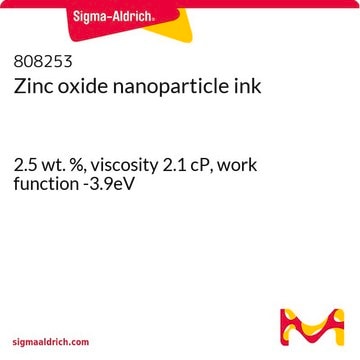721077
Zinc oxide, dispersion
nanoparticles, <100 nm particle size (TEM), ≤40 nm avg. part. size (APS), 20 wt. % in H2O
Synonyme(s) :
Zinc monoxide, Zinc white
About This Item
Produits recommandés
Forme
dispersion
nanoparticles
Concentration
20 wt. % in H2O
Taille des particules
<100 nm (TEM)
Taille moy. des particules
≤40 nm (APS)
pH
7.5±1.5
Densité
1.7 g/mL±0.1 g/mL at 25 °C
Chaîne SMILES
[Zn]=O
InChI
1S/O.Zn
Clé InChI
XLOMVQKBTHCTTD-UHFFFAOYSA-N
Vous recherchez des produits similaires ? Visite Guide de comparaison des produits
Catégories apparentées
Description générale
Application
Mentions de danger
Conseils de prudence
Classification des risques
Aquatic Chronic 2
Code de la classe de stockage
12 - Non Combustible Liquids
Classe de danger pour l'eau (WGK)
WGK 2
Point d'éclair (°F)
Not applicable
Point d'éclair (°C)
Not applicable
Certificats d'analyse (COA)
Recherchez un Certificats d'analyse (COA) en saisissant le numéro de lot du produit. Les numéros de lot figurent sur l'étiquette du produit après les mots "Lot" ou "Batch".
Déjà en possession de ce produit ?
Retrouvez la documentation relative aux produits que vous avez récemment achetés dans la Bibliothèque de documents.
Les clients ont également consulté
Articles
Operation principle and market dominance of single crystalline silicon solar cells.
Organic photovoltaics (OPVs) represent a low-cost, lightweight, and scalable alternative to conventional solar cells. While significant progress has been made in the development of conventional bulk heterojunction cells, new approaches are required to achieve the performance and stability necessary to enable commercially successful OPVs.
Among various ceramics, one-dimensional (1-D) piezoelectric ceramics have attracted significant scientific attention for use in energy harvesting.
TiO2 exhibits wide band gap semiconductor and memristor properties electronically, with high opacity and UV absorbance optically.
Notre équipe de scientifiques dispose d'une expérience dans tous les secteurs de la recherche, notamment en sciences de la vie, science des matériaux, synthèse chimique, chromatographie, analyse et dans de nombreux autres domaines..
Contacter notre Service technique







